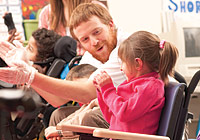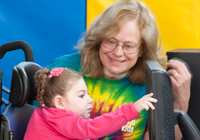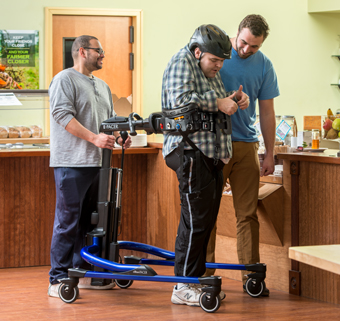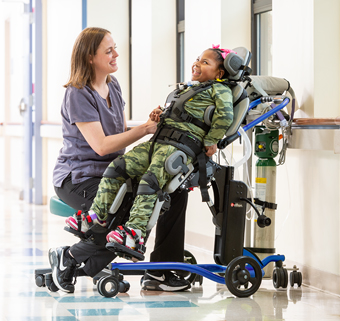Symmetrical Posturing and Adaptive Seating for Task Participation
Welcome to part III, the final post of the series on adaptive seating.
| April 2011Adaptive seating is a big part of pediatric and school-based therapy. Active sitting chairs, through providing unique features and prompts, support postures that enable. With this in mind, the following post series will be dedicated to exploring the concepts and benefits of adaptive seating. The first post – Active Sitting for Task Participation: The Role of Adaptive Chairs – is introductory and will get you off to a good start. Then, learn more with the next post – Pediatric Adaptive Seating Benefits: Doing Away with Passive Seating. And here is the final post in the series: Symmetrical Posturing and Adaptive Seating for Task Participation. Full acknowledgment for concepts regarding adaptive seating for task performance is credited to Karen M. Kangas OTR/L. Material has been presented at the 18th International Seating Symposium and published in Rehab Management.
 Adaptive Seating for Task Participation
Adaptive Seating for Task Participation
Let’s look again at the active, functional sitting of healthy able–bodied people. The individual’s shoulders and head are in front of the pelvis, rather than in line with or behind the pelvis. Feet are on the floor, are weight–bearing, and may not be symmetrically placed. The knees are held at a posture "below" or "under" the body, with both hamstrings and quadriceps muscles co–activated. The pelvic movement into anterior tilt cues the entire body to sit with increased tone, power, and alertness: in short, to become ready to perform a task. The active sitting posture can be viewed as the posture used to get up from sitting to standing, but without getting up: leading with the head, the pelvis in anterior tilt, legs weight bearing, and shoulder girdle in front of the pelvis.
Appropriate adaptive seating equipment can simulate this by providing a firm seat with sufficient seat depth. A slight forward seat angle of the chair can provide the posterior thighs with tactile/kinesthetic input, and encourage anterior pelvic tilt for weight bearing of the pelvis and lower extremities. A well–designed pelvic harness prevents forward sliding of the pelvis into a posteriorly tilted, sacral sitting position. Leg straps can be secured around the front of the lower legs, and the footboard can be positioned to graze the bottom of the feet.
The seat back is placed at shoulder height. Antero–lateral trunk support is provided as a cue to the trunk rather than as secure positioning, and thus is present when the individual brings the trunk forward. Adaptive seating for children options for support at the forearms include forearm prompts or a tray for a secure base of support that will enable upper body weight bearing–assist for trunk stabilization and postural control of the head and shoulder girdle.
In this way, even an individual with high or fluctuating tone finds that their tone now contributes to power for real task use. With containment of the pelvis, support at the lower legs and optional weight bearing–assist at the forearms, active sitting results in extensor muscle tone that improves head control, rather than the extensor pattern of pushing off the footrest into a dysfunctional extension posture. Providing adaptive seating for function in this way may even make the use of head support or a chest strap unnecessary, as the individual’s head and upper body shows progressive improvement in postural control. Individuals may now use their head as an extremity to control assistive technology with a head switch.
 Controlled Movement with Active Sitting Equipment
Controlled Movement with Active Sitting Equipment
In active, functional sitting, the individual must be able to move — by controlling the movement. This pelvic and trunk control is learned through repeated practice of an activity which is enjoyed. Observe closely as the individual works for short periods of time at the activity (less than 10 minutes). Make note of their active sitting performance in the context of the task and carefully assess seating supports as to their true value. The goal is to provide just enough support to enable a challenge for practice, but not so much support that active practice isn’t possible.
For example, if the seat is anteriorly tilted too much, the individual may lose trunk control. If the anterior support (at forearms or chest) is not adequate, the trunk may collapse forward. If the pelvis is not adequately stable, the lower extremities may kick out, show increased tone, or move into abduction. With good pelvic stability, the lower extremity supports can be minimized. If the feet are pushed against the footrest causing pelvic and trunk extension, consider lowering the footrest.
Sitting for task participation is not a seated posture to be maintained for long periods. For able-bodied individuals, this position is one that is assumed, maintained, and then moved from as it relates to a particular task being performed. So adaptive seating, too, should allow a change in postures. This can best be implemented with adaptive seating equipment features that offer adequate support without excessive restriction, along with the use of the tilt–in–space function for rest periods.
As the individual gains experience with "active holding" and "controlled moving" in this posture, he or she becomes better able to initiate and maintain active sitting. As strength, posture, and motor control improve, supports can be reduced. In time, while seated, these individuals will more readily replicate the required movements that the functional task or routine may demand.
Source:
Kangas, Karen M. Seating for Task Performance. Instructional Session. 18th International Seating Symposium 2002.Accessed March 2010.
Related Research:
Chung J, Evans J, Lee C, Lee J, Rabbani Y, Roxborough L, Harris SR. Effectiveness of adaptive seating on sitting posture and postural control in children with cerebral palsy. Pediatric Physical Therapy 2008 Winter; 20(4):303-17. PubMed Link
Hadders-Algra M, van der Heide JC, Fock JM, Stremmelaar E, van Eykern LA, Otten B. Effect of Seat Surface Inclination on Postural Control During Reaching in Preterm Children With Cerebral Palsy. Phys Ther 2007. PubMed Link
Myhr U, von Wendt L, Norrlin S, Radell U. Five–year follow–up of functional sitting position in children with cerebral palsy. Dev Med Child Neurol 1995;37(7):587-596. PubMed Link
Rigby PJ, Ryan SE, Campbell KA. Effect of adaptive seating devices on the activity performance of children with cerebral palsy. Arch Phys Med Rehabil 2009 Aug;90(8):1389-95. PubMed Link
Ryan SE, Campbell KA, Rigby PJ, Fishbein-Germon B, Hubley D, Chan B. The impact of adaptive seating devices on the lives of young children with cerebral palsy and their families. Arch Phys Med Rehabil 2009 Jan; 90(1):27-33. PubMed Link
Stavness C. The effect of positioning for children with cerebral palsy on upper–extremity function: a review of the evidence. Phys Occup Ther Pediatr 2006;26(3):39-53. PubMed Link






